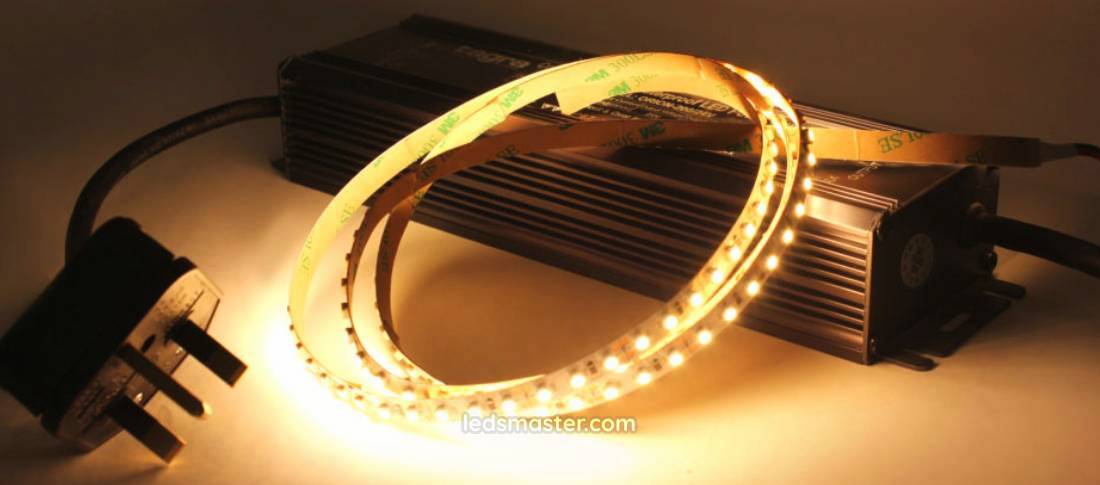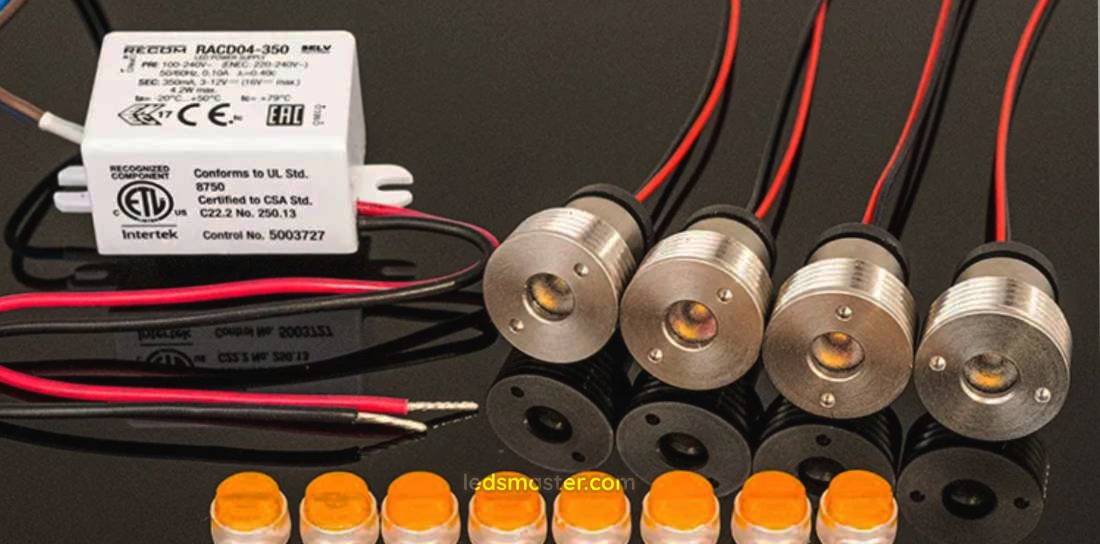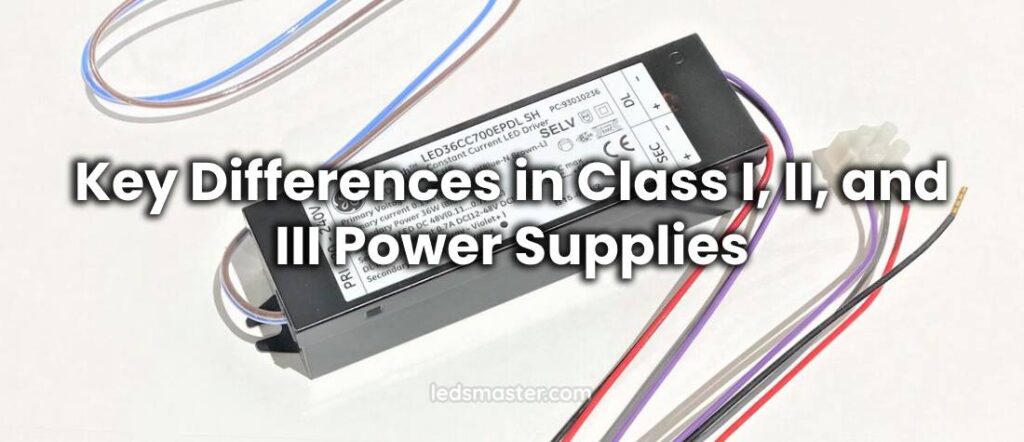Understanding the differences between Class I, Class II, and Class III power supplies helps engineers and designers choose the right power supply for their projects. Each class is designed with unique characteristics, safety features, and applications in mind.
Table of Contents
ToggleOverview of Class I, II, and III Power Supplies
Class I
Class I power supplies are designed with safety mechanisms that include grounding for protection against electrical shock. These supplies typically operate at higher voltages and currents, which makes them suitable for demanding applications such as industrial machinery and medical devices. Grounding ensures that in the event of a fault, the excess current is diverted away from the user and into the ground, minimizing the risk of electric shock.
Class I power supplies are often found in environments where robust operation is required. They are constructed to withstand harsh conditions, which makes them ideal for industries such as manufacturing and healthcare. The compliance with safety standards, such as UL 60950 for information technology equipment and IEC 60601 for medical devices, further reinforces their reliability.
Despite their advantages, Class I power supplies can be more complex and costly to implement due to the additional safety features required, such as grounding systems and protective enclosures.
Class II
Class II power supplies offer a different approach to safety. These units are designed without a grounding requirement, relying instead on double insulation to prevent electric shock. They typically operate at lower voltage levels, which enhances safety for general consumers. This class of power supplies is prevalent in household electronics and small appliances, where safety and simplicity are paramount.
The double insulation in Class II power supplies consists of two layers of insulating material, which effectively separates the electrical components from the user. This construction ensures that even if the first layer of insulation fails, the second layer provides adequate protection against electric shock.
Class II power supplies are often more cost-effective than Class I options, making them a popular choice for manufacturers of consumer products. However, their design limits their use to applications where the power requirements are lower.
Class III
Class III power supplies operate at very low voltage levels, typically below 60 volts, and are designed to be inherently safe. They eliminate the risk of electric shock, making them suitable for use in environments where users may come into direct contact with the power supply. Common applications for Class III power supplies include LED lighting systems and other low-voltage devices.
These power supplies do not require grounding or extensive insulation measures because their low voltage inherently reduces the risk of electric shock. Class III power supplies are often lightweight and compact, making them convenient for applications where space is limited.
While Class III units provide a high level of safety due to their low voltage operation, they are limited in terms of power output, making them unsuitable for high-demand applications.
Safety Considerations
Safety is a paramount concern in the design of power supplies. Each class has distinct safety features and compliance requirements.

Class I
Class I power supplies are equipped with grounding and bonding mechanisms that provide additional layers of protection against electrical faults. The grounding system is designed to carry fault current away from the user, thereby preventing electric shock. Compliance with established safety standards ensures that these power supplies can withstand rigorous testing and operational demands.
Class I power supplies often include circuit protection features such as fuses and circuit breakers, which help prevent damage from overcurrent or short circuits. These components are essential in maintaining the integrity of both the power supply and the connected equipment.
Class II
The safety of Class II power supplies is maintained through double insulation, which is designed to prevent any electrical contact with live parts. This feature is especially valuable in consumer products where grounding may not be feasible. The absence of a grounding requirement simplifies installation and usage, making these power supplies particularly user-friendly.
Class II designs are also subjected to thorough insulation testing to verify their performance under various conditions. This testing is essential to ensure that the materials used in the construction of the power supply can withstand electrical stress without failing.
Class III
Class III power supplies prioritize safety by operating at low voltage levels, thus inherently reducing the risk of electric shock. The lack of need for grounding or extensive insulation simplifies their design and use. This makes Class III power supplies a common choice for applications where safety is paramount, such as in public spaces or residential lighting systems.
Because they operate under 60 volts, Class III power supplies are less likely to cause severe injury in the event of accidental contact. These features make them suitable for environments that require frequent interaction with users.
Connection Methods
The method of connecting power supplies varies based on the class, affecting installation practices and user experience.
Class I
Connecting Class I power supplies involves the use of three-prong plugs or hardwiring, which includes a dedicated ground wire. This ensures that the grounding system is properly implemented, providing the necessary safety features. It is crucial to adhere to wiring standards during installation to prevent grounding issues that could compromise safety.
Typical connection methods include terminal blocks and hardwiring to electrical panels. Considerations for circuit protection, such as the inclusion of fuses or circuit breakers, are vital to protect both the power supply and the connected devices from electrical faults.
Class II
Class II power supplies are typically connected using two-prong plugs that do not require grounding. Instead, these connections rely on polarized connectors to ensure proper installation and reduce the risk of electrical shock. The design allows for simpler installation and reduced complexity in electrical systems.
Insulation requirements are a critical factor when connecting Class II power supplies. Care must be taken to ensure that the insulating materials used are compliant with safety standards and capable of preventing any potential contact with live parts.
Class III
Class III power supplies connect to devices using terminal blocks or plug connectors, emphasizing ease of use and safety. The low voltage operation means that users can connect these supplies without the same level of concern for electric shock that accompanies higher voltage systems.
Ensuring correct polarity in connections is essential, as reversed connections can cause device malfunction or damage. Clear labeling and user instructions can help mitigate this risk, making Class III power supplies user-friendly and safe for everyday applications.
Selecting the Best Driver for LED Lights
The selection of a driver for LED lights requires careful consideration of several factors to ensure compatibility and optimal performance.

Compatibility with LED Specifications
When choosing a driver, it is essential to match the specifications of the LED lights. This includes understanding the required voltage, current, and wattage. Class I, II, and III drivers have different characteristics that may influence compatibility. For instance, Class I drivers typically handle higher power requirements, while Class III drivers operate at lower voltage levels.
Incorrectly matching a driver to an LED light can lead to performance issues, including flickering or inadequate brightness. Thus, verifying that the driver meets the specific requirements of the LED fixtures is crucial.
Dimming Options and Features
Many LED applications benefit from dimming capabilities, which allow users to adjust brightness levels according to their preferences. Different drivers offer various dimming technologies, such as pulse-width modulation (PWM) and analog dimming. When selecting a driver, it is important to consider whether the dimming features are compatible with the intended application.
Class II and III drivers may have specific limitations on dimming capabilities, which should be evaluated based on the requirements of the LED system. Ensuring that the selected driver supports the desired dimming method will enhance the overall user experience.
Efficiency and Heat Dissipation
Efficiency is a key consideration in power supply design, affecting both performance and energy consumption. Selecting a driver with high efficiency ratings will reduce energy waste and lower operational costs over time. In LED applications, minimizing heat generation is also important, as excessive heat can shorten the lifespan of both the driver and the LEDs.
It is advisable to review performance metrics, such as efficiency ratings and thermal management features, when choosing a driver for LED lights. A well-designed driver will provide optimal performance while maintaining low heat output.
Performance Metrics
Evaluating performance metrics is essential when comparing Class I, II, and III power supplies. These metrics can help determine the suitability of a power supply for a specific application.
Key Performance Indicators
Efficiency ratings are among the most important performance indicators for power supplies. High-efficiency models, such as those certified by 80 PLUS, indicate better energy utilization and lower operational costs. This is particularly valuable in applications where power consumption is a significant factor.
Load regulation and voltage stability are also critical performance metrics. These indicators assess how well a power supply maintains a stable output voltage under varying load conditions. High-quality power supplies will demonstrate minimal voltage fluctuations, which is crucial for sensitive electronic equipment.
Performance Comparison Across Classes
Comparing the performance of Class I, II, and III power supplies reveals notable differences. Class I power supplies often excel in efficiency and load regulation due to their robust design and higher power handling capacity. In contrast, Class II power supplies may offer sufficient performance for lower power applications but may not match the efficiency of Class I.
Class III power supplies, while safe and user-friendly, tend to have limited output capacity and efficiency compared to the other classes. Their primary advantage lies in their inherent safety features and suitability for low-voltage applications.
Cost Considerations
The cost of power supplies varies significantly across classes, influenced by design complexity and safety features.
Initial Costs
Class I power supplies generally have higher initial costs due to their advanced safety features and robust construction. The need for grounding and additional protective components adds to the overall expense. However, these costs may be justified in applications requiring high reliability and safety.
Class II power supplies tend to be more affordable, appealing to manufacturers producing consumer electronics and small appliances. The absence of grounding requirements simplifies design and reduces costs, making them an attractive choice for budget-conscious projects.
Class III power supplies usually represent the most economical option, primarily because of their simple design and low voltage operation. These units are well-suited for low-power applications, making them a cost-effective choice for LED lighting and similar uses.
Long-Term Costs
Long-term costs are an important consideration when evaluating power supplies. Class I power supplies may incur higher maintenance and operational costs due to their complexity and need for grounding systems. However, their reliability can lead to lower replacement costs over time.
Class II and III power supplies, while initially less expensive, may lead to increased operational costs if their efficiency is not optimized. It is essential to balance initial costs against potential long-term savings when making a selection.
Cost-Benefit Analysis
Conducting a cost-benefit analysis helps assess the value of investing in a particular class of power supply. This analysis should consider the specific application requirements, safety needs, and potential risks associated with each class. By weighing these factors, engineers can make informed decisions that align with project goals and budgets.
Troubleshooting Common Issues
Grounding Issues
Grounding problems can lead to operational failures and serious safety concerns. Proper grounding is essential for the safe operation of power supplies, as it directs fault currents away from sensitive components and minimizes the risk of electric shock. Loose or corroded grounding connections can prevent the system from functioning as intended, creating pathways for dangerous voltage levels to surface. Regular inspection of grounding connections is critical to ensure their integrity, particularly in environments where vibration or movement can cause disconnections. If grounding issues are detected, they should be promptly addressed to prevent equipment damage and maintain safety standards. Implementing a routine maintenance schedule that includes checking all grounding connections can help identify potential problems before they escalate into more significant issues.
Overheating
Overheating is a significant concern for power supplies, especially in enclosed or poorly ventilated spaces. When power supplies do not receive adequate airflow, internal components can reach elevated temperatures that may lead to premature failure. High temperatures can affect the lifespan of critical components, such as capacitors and transformers, leading to reduced efficiency and potentially catastrophic failures. Regular maintenance checks that include monitoring temperature levels and ensuring proper ventilation are vital for optimal performance. Installing additional cooling solutions, such as fans or heat sinks, may be necessary in high-load scenarios or environments with high ambient temperatures. It is also important to ensure that dust and debris do not obstruct ventilation paths, as these can trap heat and further exacerbate overheating issues.
Insulation Failures
Insulation failures can pose serious risks to both equipment and personnel. Power supplies often rely on double insulation to protect users from electric shock, and any compromise in this insulation can significantly increase safety hazards. Common causes of insulation failure include physical damage, aging materials, and exposure to environmental factors such as moisture or chemicals. Regular inspections should focus on identifying wear, discoloration, or any signs of degradation in insulating materials. Additionally, testing the integrity of insulation using specialized equipment can help detect problems that may not be visually apparent. Addressing insulation failures promptly is crucial to maintain safety and compliance with regulatory standards. Implementing preventative measures, such as using high-quality materials and proper environmental controls, can further reduce the risk of insulation-related issues.
Voltage Spikes
Voltage spikes present a considerable challenge for power supplies, as they can cause sudden surges in power that may lead to device malfunctions or permanent damage. These spikes can occur due to various factors, including lightning strikes, switching actions in the electrical grid, or faults in connected devices. To protect sensitive equipment, it is essential to use surge protection devices that can absorb and redirect excess voltage before it reaches the power supply and connected components. Additionally, installing voltage regulators can help stabilize power levels, ensuring that devices receive consistent and safe voltage. Regular maintenance should include testing surge protection devices to confirm they are functioning correctly and replacing them when necessary. Furthermore, educating users about the signs of voltage spikes and their potential impacts can promote proactive measures in safeguarding equipment.
Low Voltage Failures
Low voltage failures can lead to insufficient performance if a power supply is not properly rated for the connected devices. This issue often arises when users mistakenly assume that any power supply will suffice for their needs, disregarding specifications such as voltage and current ratings. When connected devices do not receive the necessary voltage, they may operate inefficiently or fail to function altogether. To prevent low voltage failures, it is crucial to ensure compatibility between the power supply and the connected devices, carefully reviewing the specifications before installation. Conducting routine checks on voltage levels during operation can also help identify discrepancies early on. Additionally, using power supplies with adjustable output settings can provide flexibility in accommodating different devices, reducing the likelihood of low voltage issues.
Short Circuits
Short circuits can disrupt the operation of power supplies, particularly if connections are improperly established. A short circuit occurs when electrical current flows along an unintended path, often due to faulty wiring or loose connections. This can lead to overheating, equipment damage, or even fire hazards. To mitigate these problems, clear labeling of all connections is essential, making it easier for users to identify proper wiring configurations. Comprehensive user instructions should accompany power supplies, detailing safe installation practices and warning signs of potential short circuits. Regular maintenance that includes inspecting wiring and connections for wear or damage is also vital. Educating users about the risks associated with short circuits and the importance of using high-quality connectors can further promote safe and effective operation of the system. Implementing circuit protection measures, such as fuses or circuit breakers, can provide an additional layer of safety by interrupting the current flow in the event of a short circuit, thereby preventing further damage.
Conclusion
Understanding Class I, II, and III power supplies is crucial for selecting the right unit for different applications. Class I supplies are best for high-demand environments with grounding for safety, Class II offers a simpler solution for consumer electronics, and Class III is suitable for low-voltage applications prioritizing user safety. As technology advances, innovations in power supply design and energy efficiency reshape their use. By assessing the unique characteristics of each class, engineers can make informed choices that enhance reliability and performance in various systems.

